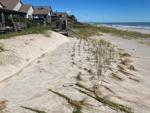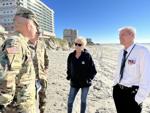Mount Pleasant condominium owner Jay Smith recently saw his monthly regime fee rise 10 percent to nearly $400 a month.
The price hike came after the company that provides hazard insurance for the eight-building, 64-unit complex off Shem Creek where the retiree lives hiked its premium by $27,000 this year, or 52 percent, to renew the policy.
Other condo owners along the South Carolina coast soon could see similar spikes for the monthly fee they pay in association dues to cover expenses such as landscaping, roof repairs, painting, amenities and insurance when their policies come up for renewal.
Insurance brokers who help condo associations try to find competitive rates from carriers blame the surging costs on the rash of natural disasters such as hurricanes, wildfires and other calamities across the U.S. during the past few years. Recent storms, to name a few, include Harvey in 2017, Michael in 2018, Dorian in 2019, Laura in 2020, Ida in 2021 and Ian in 2022.
Last year was the eighth consecutive year when 10 or more billion-dollar weather and climate disaster events affected the U.S., according to the National Centers for Environmental Information, an arm of the National Oceanic and Atmospheric Administration. During the previous three decades, the government logged five similar years.
That’s led to fewer companies serving the coastal condo market because they can no longer afford to cover all of the potential losses from structural damage.
“We are down to four or five providers that can be competitive when three years ago we had 12 or so,” said Isaac Matthews, a broker with Brown & Brown Insurance in North Charleston which helps condominium management companies try to find the best rates when it’s time for their association clients to renew coverage each year.
“The past five years in a row of catastrophic losses have affected their underwriting profits, so they are going to pull away from that sector of business or move out of the territory altogether,” he said.
Paying a premium
Matthews and other brokers are sounding the alarm that some condo owners could be in for sticker shock when their policies come up for renewal this year. To offset the higher premiums, governing boards have few alternatives other than cutting services, raising dues or imposing special assessments.
“The best-case scenario is a 30-35 percent increase in premiums,” Matthews said. “We are facing one of the most challenging years in the last decade.”

He pointed to a 36-unit condo complex on Daniel Island as a recent example. The annual premium for hazard insurance to cover damage from fire, wind, hail, earthquakes and hurricanes more than tripled to $223,000 from $71,000.
“The previous provider is no longer writing (hazard coverage) that close to the coast,” Matthews said.
He cited another example, saying rates for a 153-unit complex in North Charleston more than doubled to $181,000 a year.
The rising insurance rates are not confined to the Lowcountry.
“It’s a problem along the entire coast,” Matthews said.
In the Myrtle Beach area, some condo associations could see rates balloon by 300 percent, said Mike Almond, a broker with Acentria Insurance on Pawleys Island.
Some of the main carriers for areas within three to five miles of the coast have exited the market because of the hurricanes, wildfires and other disasters affecting the U.S. last year.
“Hurricane Matthew (in 2016) and Hurricane Michael (in 2018) started the strain on carriers, and Hurricane Ian (in 2022) put the nail in the coffin,” Almond said.

Underwriters are now being picky.
“They want to insure a building that can withstand a Category 4 or Cat 5 hurricane,” he said.
He noted that “most of the construction on the coast” dates back to mid-1980s, “and a lot of the carriers don’t want to touch it.”
‘No end in sight’
Matthews of Brown & Brown said some of the factors pushing rates higher include the increased demand for coverage, the rising costs of rebuilding homes and higher appraised values of older structures. That’s in addition to other standard considerations, such as the distance to the shoreline, the year a property was built and claims history.
“The few insurance companies that are still willing to place coverage are being very selective on risk quality,” Matthews said.
Like Matthews, Almond called the current premium increases the largest he’s seen in quite a few years.
“If our hurricane season this year is bad, you will definitely feel (the financial impact) even more at the end of the year,” Almond said.
Another pricing wrinkle for the industry is the so-called reinsurance market, which provides policies that carriers buy to cover some of their risks. It’s tapped out.

Matthews said the reinsurance money supply is down $50 billion while demand last year was up about $30 billion.
“This means there is currently an $80 billion gap between insurance companies’ capacity and insurable property values,” he said.
Owners of single-family homes along the coast aren’t feeling as much of a price sting because that market isn’t short on carriers, making it easier to obtain coverage.
“There are only so many companies willing to insure a 200-unit property valued at $50 million, for instance, rather than a house for $500,000,” Matthews said.
He also pointed out hazard insurance does not include flood protection, which is another policy altogether. It also does not cover problems with structural integrity, which is a maintenance issue.
Jason Besse, a broker with Correll Insurance Group of Summerville, said the market for hazard insurance is cyclical, with rates typically rising after major disasters. He doesn’t see costs coming down anytime soon.
“There is no end in sight this go round,” Besse said. “It’s a bad deal. We don’t have the capacity to fill the risk, and there are fewer players in the carrier and reinsurance markets.”
For condo owners such as Smith in Mount Pleasant, who retired and moved to the Lowcountry from West Virginia several years ago, the trend is troublesome.
“If the rates keep going up, it’s going to become unaffordable for some people,” he said.

Clinton Mora is a reporter for Trending Insurance News. He has previously worked for the Forbes. As a contributor to Trending Insurance News, Clinton covers emerging a wide range of property and casualty insurance related stories.


